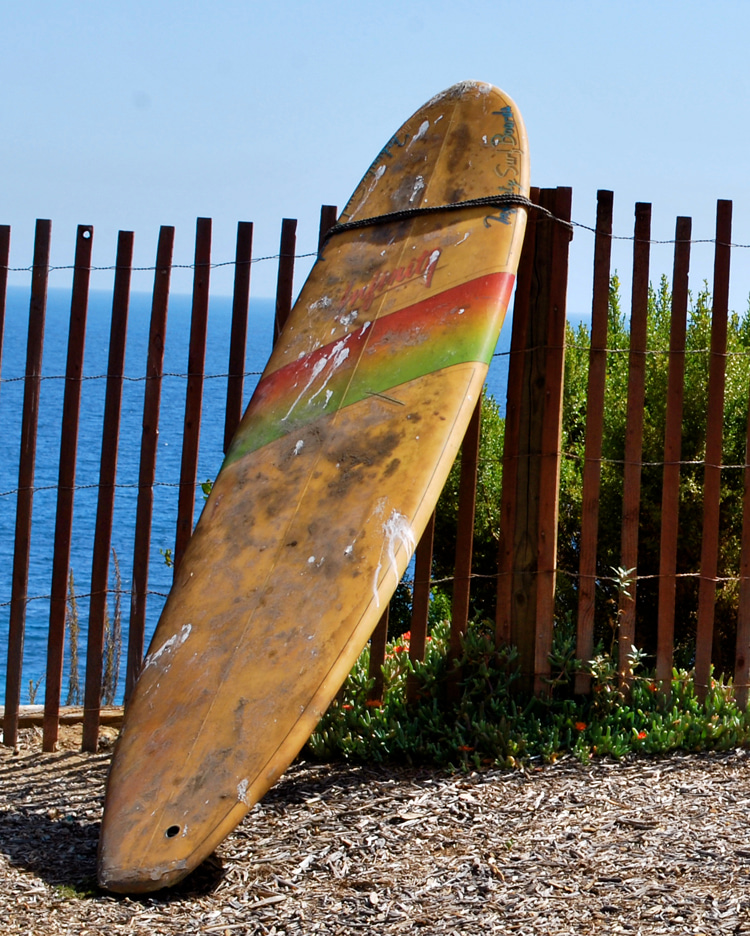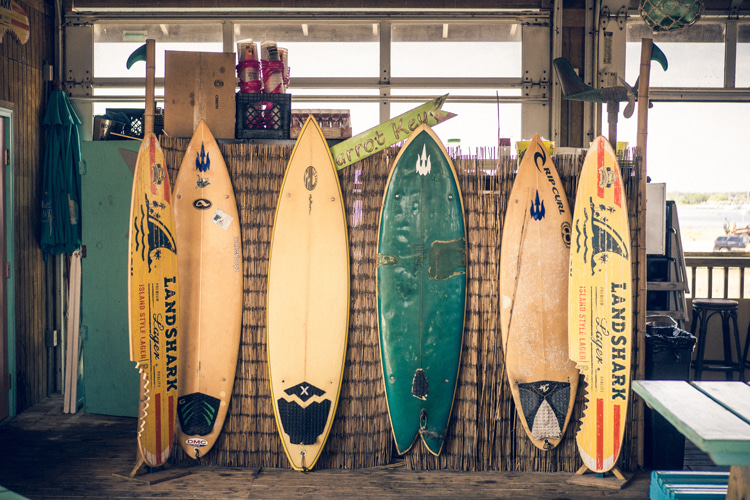Surfboards, like any surf equipment, require regular maintenance and attention.
Over time, they can develop issues that affect their performance, appearance, and lifespan.
One of those problems is "delamination," a term that refers to the loss of coating adhesion to a surface or between layers, mostly in polyurethane-based surfboards.
As a result, you'll notice that the fiberglass coating is pushed inward, creating more or less pronounced bowls on the deck or bottom of your surfboard.
In other words, a delaminated board sees the top glass layer separated from the inner polyurethane foam.
This problem, while serious and more complex than a simple ding repair, can be managed and repaired if you understand its intricacies.
When Is A Surfboard Declared "Dead"?
Before we delve into the heart of delamination repairs, we must grasp the concept of "dead" surfboards.
The term doesn't refer to a ghostly apparition but to boards that have seen better days and might be past their prime.
Boards can be categorized as "dead" when:
- They're broken beyond repair;
- Repair costs are near those of a new or used replacement;
- The core remains waterlogged and cannot be dried;
- The glass becomes so brittle that it cracks under slight pressure;
- Brown spots dominate the polyurethane (PU) core, making it look like it's rotten;
However, even if your board might seem dead, there's a silver lining: many issues, including delamination, can be fixed.
And that leads us to our next point.

Why Should You Consider Fixing a Delaminated Surfboard?
First, delamination will spread if left unattended, potentially making the board unsafe or unusable.
Yet, the decision to repair boils down to personal choice.
If you're adept at DIY projects, fixing a board can save you money and offer a sense of achievement.
As one seasoned DIYer noted, "It's oftentimes more ecological and environmental to fix stuff. There's also the great satisfaction of repairing your own gear."
Plus, if you cherish your board and have the means, then revitalizing it might be a no-brainer.
Now, if you've nodded along so far, let's embark on a journey to restore that delaminated surfboard.
Materials
Here's a list of materials needed to fix and repair a surfboard delamination:
- Marker;
- Dremel with a cutting blade;
- Sandpaper (220, 400, and 600 grit)
- Resin + Q Cell mixture;
- Fiberglass patches;
- Laminating resin;
- Hot coat resin;
- Pigment (optional);
- Posca pen or equivalent (optional);
- Syringe (traditional method only);
Tools and materials like brushes for applying resin, a workspace, protective gloves, and safety goggles might also be essential.
Always ensure you work in a well-ventilated space and follow safety guidelines when handling and applying chemicals or using tools.
Surfboard Delamination Repair 101
A basic delamination can be addressed using a traditional method.
That is employing a large hospital syringe to inject a resin-hardener blend into the delaminated bubble via a tiny opening and then pressing the fiberglass layer back onto the foam.
You're essentially utilizing the resin as an adhesive. However, this is not the best method.
The best way to repair a delaminated surfboard is the "surgery" method, as it makes your plank lighter and stronger.
- Assessment and Preparations: Begin by identifying the delaminated areas. Remember, these are places where the fiberglass begins separating from the foam, causing a bubble;
- Remove Damaged Fiberglass: Mark the zones that need attention with a marker. Using a Dremel or a similar tool fitted with a cutting blade, carefully remove the compromised fiberglass;
- Let it Dry: Once the affected area is open, leave the wet PU to dry for a few hours;
- Sand the Exposed Foam: With the foam now visible, gently sand it to eliminate any damaged portions. Also, make sure to sand the surrounding fiberglass to ensure a seamless repair later;
- Fill the Affected Area: Mix a compound of resin and Q-Cell to recreate the foam's structure. You can add pigment to this mixture to address any discoloration or match the board's original hue. Aim to slightly under-fill the damaged spot. This strategy reduces subsequent sanding and allows for a better blend;
- A Second Round of Sanding: After the resin mixture cures, smooth the area in preparation for the next layer of fiberglass;
- Laminate with Fiberglass: Cut out fiberglass patches - usually two for each damaged area - and adhere them to the board using laminating resin;
- Final Sanding: While not always necessary, sanding after the fiberglass cures helps the patch blend in seamlessly. Start with a 220-grit sandpaper, followed by a 400-grit pass, and end with a 600-grit wet sand;
- Pinlines: If your board has pinlines that were disturbed during the repair, attempt to redraw them. One approach is to use a Posca pen. However, be cautious; as board repair aficionado Sam Hoynacki first learned the hard way, "I did this on the fiberglass when I should've done it on the hot coat." As a result, the ink bled, leading to a less-than-perfect outcome;
- Hot Coating: Apply a thin layer of hot coat resin over the patches. Once satisfied with its smoothness, allow it to cure;
- The Final Touch: After the hot coat has set, engage in one last sanding session to ensure a polished look;
Ultimately, with diligence and care, you can breathe new life into a surfboard plagued by delamination.
Whether you're preserving memories or extending the board's lifespan, taking the time to repair is often a worthy challenge.
Remember, every patch, every sanding stroke, and every coat of resin adds not just life but a story to your board.
